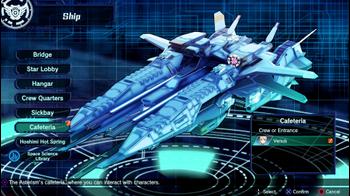
Relayer Review
Name a more iconic duo in video games than strategy RPGs and mecha. Alright, you probably can, but it’s undeniable that these two genres seem to love intermingling often with notable ones like Front Mission, Super Robot Wars, SD Gundam G Generation, and so on.
Relayer comes from the development team behind 2017’s God Wars: Future Past at Kadokawa Games. Where God Wars’ systems were more inspired by Tactics Ogre and Final Fantasy Tactics, Relayer is more of a light amalgamation between Fire Emblem and Super Robot Wars. It’s difficult to point to a 1:1 comparison of Relayer’s battle mechanics because the inspirations it takes from other strategy RPGs have been molded into something that isn’t quite like anything else.
I was surprised by how much I enjoyed Relayer. Although it contains its share of key flaws, I can see the roots of a promising new IP if Kadokawa Games decides to make a follow-up in the future. This game has an ensemble that I grew to absolutely adore, an interesting battle system that could stand to see some refinement over time, and a job system that is almost great. Most of my gripes with Relayer stem from its lackluster presentation, especially in the English localization script and the quality of the English audio dub.
My positivity comes with a significant caveat; the first three to four hours are easily the weakest part of Relayer. It takes a good chunk of time to get things off the ground - both in its story and gameplay. I wasn’t too sure I’d even like the game that far in, yet it somehow turned it around.

As Relayer starts, players are introduced to the basic premise of Relayers as extraterrestrial beings bent on destroying the universe. The ones with the power to stop them are the Starchildren, chosen humans who have inherited the will of the stars. Terra, the Starchild of Earth, is Relayer’s main character; thankfully, this naming convention makes it very simple to keep track of the Starchildren because they’re all named after the celestial bodies they represent - Mercury, Venus, Jupiter, Saturn, Sun, and such.
Before the game begins, players learn that Terra lost her sister in a catastrophic event several years prior, when Earth’s gravity ceased to function temporarily at a specific spot on the planet. Terra’s sister flew into the sky and presumably died. Due to the immense trauma, Terra lost all memories of who she was before the Gravity Loss incident transpired. Now, she’s an aimless traveler and happens to be residing at a lunar colony with her robot buddy Yodaka.
Of course, her peaceful days come to an end when Relayers attack that lunar colony and she discovers the unthinkable as a familiar figure comes into view; her sister is not only alive, she’s also working with the Relayers. Other Starchildren also come into the scene to fend off the Relayer attack, and the rest is what you would expect. Terra has been using her gigantic Stellar Gear robot to travel from place to place, but Terra now is pushed to utilize it for combat in order to learn the truth about her sister. In order to do so, she chooses to work with the other Starchildren aboard the Asterism ship to pursue the Relayers.
Relayer’s story is filled to the brim with mecha anime tropes, and that’s not necessarily a bad thing. Fans of the Gundam franchise’s stories and characters will feel right at home here. Conspiracies, uneasy alliances, numerous factions with hidden agendas, space pirates, Newtype / Cyber Newtype equivalents, and even a Char-inspired masked character are just some of the touchstones in Relayer’s bustling 50+ hour story.
Although it is clearly and remarkably taking many pages from the Mecha Story Bible, Relayer manages to craft an engaging tale through its character interactions. Significant characters from each side of the conflict are explored to a certain degree, and a handful of its main story missions caught me off-guard because the game isn’t afraid to hand over control to unlikely characters in service of its narrative. There are some narrative developments throughout that genuinely surprised me.
I also liked that all the main story cutscenes were fully voiced - a feature that I wish the Super Robot Wars series would adopt, but I also understand why it is logistically impossible. Relayer supports a dual-audio track with English and Japanese voices, which is a very commendable feat due to the sheer amount of voiced dialogue in this game.
Unfortunately, the English audio track is relatively lacking in several ways. Some of the sound recording quality for certain characters are consistently muddy and muffled, which make them stand out when interacting with another character that is much cleaner in their line delivery. Furthermore, the English voices themselves are serviceable, yet they seem to be more dialed in and conservative compared to the energetic, bubbly delivery of their Japanese counterparts which feel more appropriate for how the cast present themselves. The English voice actors themselves are by no means bad; perhaps the issue lies more in overall voice direction. It reminded me of PlayStation 2 era English dubs for JRPGs when character line deliveries often fell flat. Therefore, I heavily recommend playing Relayer with Japanese voices.
Another disappointing aspect of Relayer is the English localization quality is a rollercoaster. Sometimes, it gets pretty bad and at other times, it is remarkably decent. The public demo of Relayer did it no favors either because it contains a good amount of noticeable typos and odd localization decisions in the game’s opening hours. I’ve also gone back and briefly compared the scripts of Relayer’s demo and final release. There are some minor fixes here and there, but most of the significant typos still remain intact, unfortunately.
These typos range from misspellings, no capitalization on certain titles, improper spacing, and missing words to complete phrases. As for odd localization quirks, an early example is when an inner voice is calling out to Terra. The dialogue box depicts this enigmatic speaker as “A voice echoing in my mind” which may be literally correct yet is admittedly quite stiff when presented in English. A more reasonable angle would be titling this inner voice as “Mysterious Voice” and putting what they have to say in parentheses to depict that this conversation is happening inside of Terra’s mind. Later on in the game, the localization script eventually does rectify this instance by eventually depicting inner voices through a similar solution, and the localizers didn’t bother to go back and correct early instances of this specific mistake. There was a single point when a special character couldn’t be rendered in the script too, so it’s just displayed as a square instead. The kerning on the English font is a bit irritating too, with the spacing between the English characters never finding a consistent balance that felt right or pleasant.
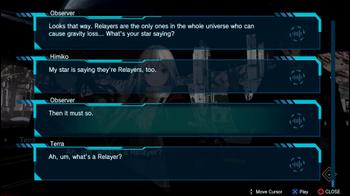
The frequency of these script errors is erratic. Playing the demo would lead you to believe they’re going to be a common occurrence, but they thankfully start to become less and less of an issue as players get further into Relayer. Don’t get me wrong; the occasional typo still pops up here and there, yet less so than the demo may lead you to believe.
Relayer’s English localization can’t entirely escape how stiff and dry some parts of it are, though. There are many lines that come off a bit too literal to the source Japanese text, which make them awkwardly flow in English. Once again, it is serviceable at the end of the day and it doesn’t permeate through every single nook and cranny. Some characters later on somehow avoid it altogether with a more distinct, natural-sounding script that more accurately depicts their characterization.
With all that laid out, let’s go into how Relayer exactly plays as a strategy RPG. As you start recruiting characters through the main story, each of them is assigned one of four predetermined roles - Assaulter, Sniper, Tank, or Scout. Assaulter and Sniper are responsible for melee and ranged DPS respectively, Tanks are there to ensure they take the brunt of most incoming enemy fire to defend nearby allies, and Scouts handle auxiliary support through buffs, debuffs, and heals. Thus, Relayer opts to implement the “holy trinity” dynamic in its structure.
Each role can use different types of weapons that all strike at different ranges. One-handed and two-handed swords can only strike enemies that are right next to a character. Machine guns can hit foes two tiles away from them, while rifles and bits (think fin funnels from Gundam) can fire from even further away. The catch is that if you’re hitting an enemy that has the same firing range as you, they’ll counterattack you, and counterattacks often hurt a lot. So combat encourages different weapon types to engage one another to avoid being struck back. Both allies and enemies can initiate follow-up backstab attacks if two of them are on opposite sides of a specific unit too.
On top of this, weapons also deal two different kinds of damage via the physical and gravity attributes. Both inflict bonus damage to one another, so the big hits come when allies and foes target the opposite attribute from a range they can’t be counterattacked from. Allies can equip armor that helps mitigate damage from either type of attack.
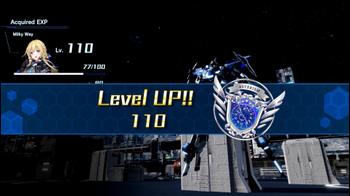
Aggro value management is one of the most important things to keep in mind throughout Relayer’s stages. The higher a character’s aggro value, the more likely they are to be targeted by nearby enemies. It naturally accumulates by attacking, buffing, debuffing, and healing; getting attacked decreases it. There are many abilities that manually manipulate aggro value as well.
Throughout battles, there’s a special meter, the Big Bang Gauge, that fills up as players attack and utilize skills. Once it’s filled up a certain amount, players can unleash devastating Big Bang ultimate attacks that can’t be counterattacked. Some highly specialized abilities consume the Big Bang Gauge too.
As allies and enemies attack one another, Relayer phases into a quick battle animation cutscene that is somewhat more reminiscent of SD Gundam G Generation’s straightforward direction, rather than the overly flashy nature of Super Robot Wars. Sadly, there are only a few handful of canned animations; there aren’t any character-specific or unique animations here. There are different animations for how each of the four different roles interact with the enemy’s similar four roles and the small selection of big bosses, along with Big Bang attacks. They get old pretty quickly for me, so I turned them off eventually.
Readers, if you’ve been following me for some time, you know that I love giant robots. So it pains me to say that oddly enough, the mecha in Relayers did not really do anything for me. They’re not awful, but they’re just mediocre with a good majority exhibiting the same skeleton and same general design philosophy. Very few stand out from the crowd and even then, their designs are rather boring to me. It feels too blocky and too strictly compartmentalized as if they were all derived from the same base blueprint. The few boss-class mecha sadly all share the same model and the only substantial thing that differentiates them are different colors.
Another bummer for me in Relayer was its lack of mission variety. Almost every single map objective is to eliminate all enemies or just a boss enemy. There were certainly story beats where an escape objective would’ve made more sense, yet the game just never quite ventured that far.

The map layouts themselves were almost a step above what you would see in recent Super Robot Wars entries, which tend to just be wide open spaces almost all the time. At least in Relayer, there are several stages that place obstacles on the battlefield so there are some sections where players will have to consider chokepoints and angle of approach. There are even some stages that separate characters into multiple squads that are barricaded from one another, so they’ll have to fend for themselves before reconvening. I wish there were more of these stages because a considerable majority are still wide open spaces.
A small part about battles that irked me was the readability of tile spaces. Players can display the threat squares of enemies at any time to get a sense of how close they can get to foes before it would “activate” their AI to respond. In trying to find the right tile space to move to, so characters can avoid preemptively activating foes, the readability of where they can move to that’s an enemy-safe zone is a mess. Certain environmental lighting on stages make the color coding of all this even more of a hassle than it should. It’s something that I had to really adjust to as time went on.
One of the major systems in Relayer that I loved tinkering with was its job system, despite being a nightmare to navigate through. Every playable character in Relayer accrues job points; everyone starts at the base class of either a Fighter, Shooter, Knight, or Wizard. As you may have surmised, each of the four roles fall into one of these base classes. The Star Cube feature allows players to unlock nodes in each class with job points. These nodes give stat bonuses, passive skills, and active skills. Once a character unlocks all the nodes for their base class, they arrive at the Grand Crossroads selection where they must select a specific job path. Players can only choose one of two selections and there is no way to respec once a selection has been made.
Thankfully, players shouldn’t feel too left out if they didn’t choose a certain path for a character early on because Relayer eventually gives a myriad of playable characters as it develops. These later characters still fall into one of the four base classes and can freely choose the other job path, so players will eventually see what every single job has to offer.
These job selections have different specializations. For instance, a Fighter can choose between the path of a Vanguard/Braver or Shinobi/Ninja. The former can increase its attack power and build up aggro quickly, so it’s a natural standard front liner. Meanwhile, the latter specializes in decreasing aggro to sneak into enemy lines and has several skills to increase its backstab damage; they also opt for skills that dodge incoming damage all together.
The way this is visualized in the game is quite neat. The Fighter icon is a sword and that icon transitions into a constellation where each star on that constellation are the nodes you learn, so it’s all thematically in-line with the game’s fascination with astrology.
Visuals are one thing, but combing through it is more of a struggle than I was expecting. Players can follow the constellation lines easily, almost like a connect-the-dot puzzle, with the left analog stick. If they want to see what a future node does, the right analog stick switches to a free cursor mode that can hover over it, yet advanced jobs have so many constellation lines intersecting with one another, it becomes overwhelming to parse which is the right path to get to a specific node. I had to basically hover over the node I wanted, then use the left analog stick to snap the cursor back into the nearest constellation line, hopefully along the line path that I wanted, and work my way backwards into the right connect-the-dots route I wanted to take for a specific node.
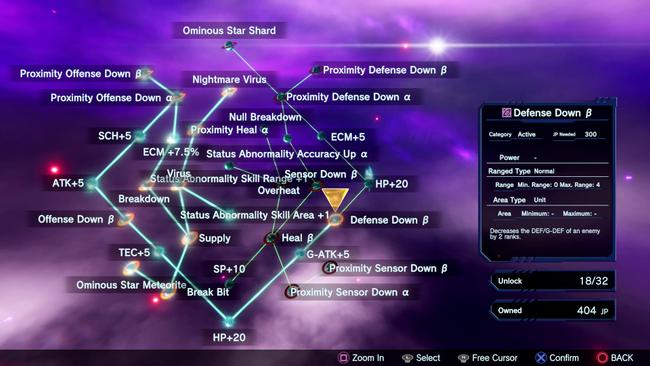
It doesn’t help that the overview for an entire job’s Star Cube quickly becomes a mess in higher jobs. The English text sometimes overlaps with another node’s text and clusters of nodes are so dense that it takes a hot second to realize which text corresponds with each node. Once again, the visualization of this job system is thematically neat, but Relayer desperately needs a more elegant UI for it.
When advancing to a higher tier of job, there are some trade-offs players have to make when they equip that job on a character. They’ll notice that almost all of their skills learned in that previous job are gone and only the character-specific named skills remain. For example, Mercury learns a lot of handy support skills in her intermediate job, the Enchanter. She gets a beefy single target heal, AoE heals, skills that recover SP to other allies, and AoE ailment heals - the whole package for what you want out of a “white mage” equivalent. When she advances into her advanced job, the Wiseman, she loses all of those Enchanter skills except her character-specific heals that consume the Big Bang Gauge. It’s a frustrating design decision, because now she basically has to relearn all of that in the Wiseman Star Cube again; there are also newer, more powerful skills in that job of course, though the decision to not carry over the “generic” active skills in-between jobs can have characters feel like they’re lacking options when they first move into a higher job.
Another feature in Relayer that is more of a hassle than it really needed to be is its basic weapon upgrade system. This is a fairly straightforward system where players buy weapons from a shop and can upgrade them with in-game currency for better stats. They can be upgraded up to four times, but there’s a frustrating quirk in all of this. At any time in those four upgrades, the game can randomly give it a Dark Side upgrade. At first, this seems really handy because it gives the weapon a considerable stat boost - until you start seeing that character take a considerable amount of damage every single time they get a turn. That’s right, the game implemented a system where a weapon can just turn into a cursed weapon, by complete random chance, every single time they’re upgraded. There’s no way to undo it; you just have to buy a new weapon from scratch again to upgrade or resort to save-scumming it.

This only inflated the amount of time it took to get all of my characters' newer gear as the shop got updated with more powerful equipment as the story progressed. I dreaded every single time the shop got a new tier of equipment because I had to re-outfit my entire squad with them, and pray that there weren’t a lot of Dark Side upgrades to reset. The constant menuing experience in this part of Relayer is not a pleasant one.
The difficulty curve in Relayer is another point of contention that I’m left mixed on. I hardly ever grinded in Relayer, and didn’t really feel the urge to until the final boss. There are optional, repeatable Battle Simulator stages that unlock as players get further in the main story, though the overwhelming majority of these stages are just exact repeats of previously completed story stages. Every main story mission and Battle Simulator stage give a recommended level, yet I found myself quickly falling behind these just by playing the game on the default difficulty and trying to deploy everyone equally, so no one fell too behind in levels. I’m warning you right now that it is a good idea to do this, instead of only choosing to focus on a “main” squad.
Even when I was underleveled, I enjoyed the challenge of outmaneuvering foes that clearly overwhelmed me in raw attack power. I felt rewarded for tactically thinking, until the final boss. I can’t really get into why for obvious reasons, but the final boss of the main story is designed to just be plain rude to players. It was a multi-hour endeavor to say the least.
Finally, this gets me to the last point I wanted to cover for Relayer. This game has one of the strangest post-game premises I have ever seen in a video game. The main story ends on an emotionally somber, bittersweet note. It hit me far harder than I thought it would, and that’s splendid.
Then, the Asterism Voyage post-game touts that it has added an all-new additional story that takes place after the main story ends. The caveat? It is a massive what-if scenario that hangs on the contingency of what-if the main story did not end the way it did and things kept rolling along as usual. This post-game essentially robs the main “canonical” story of its emotional impact in a weird way. There are already new locations locked behind this post-game mode that the main story has never touched upon too. This new story is not voiced either and makes me wonder how they’ll treat future installments should this new post-game story contain any character revelations that, perhaps, may have been more impactful if they were introduced in a potential sequel.
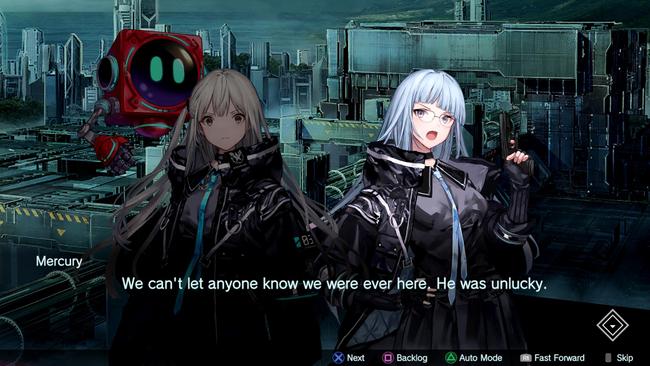
Relayer has the building blocks of a promising new IP with a compelling ensemble of characters and an intriguing world to build off of. There are too many key flaws with its English localization, its design decisions, and its UI that holds it back from being truly great, but all of those can easily be improved upon in a sequel. I hope Relayer does well enough to encourage the development team to make more because I am so interested in where they take it next, especially with the way the main story ended.
